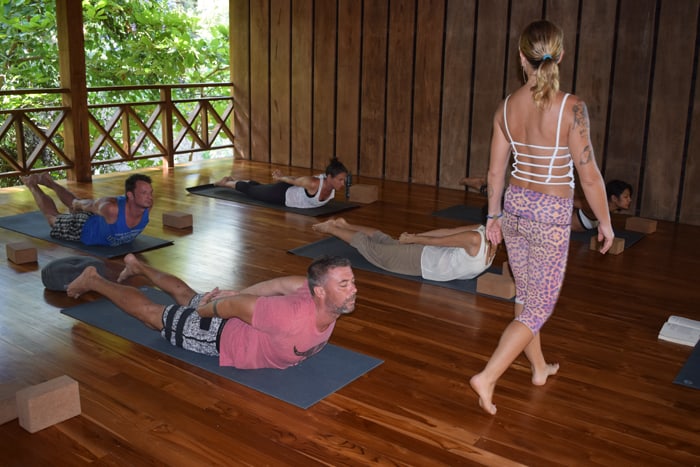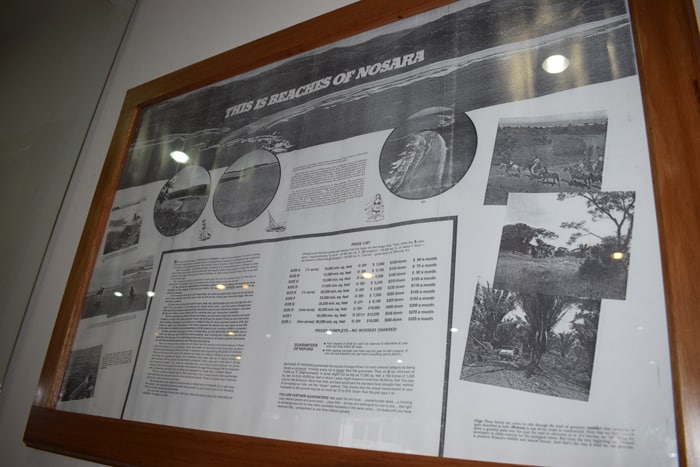NOSARA, Guanacaste — Nosara is a dusty place with a golden aura, a weird and wonderful vortex of personal, social and global consciousness, a place where people come to find themselves and sometimes never leave.
Also, believe it or not, some people make fun of it.
“What I like about Nosara is it’s a place that not everyone loves,” said Brandon Richardson of Wanderlust Realty. “Most good brands don’t appeal to everyone.”
Nosara is a major yoga capital, a teacher of teachers, and a first-class surf destination, but it’s more than the sum of its parts. It’s ideally situated on a pristine coastline teeming with birds, reptiles, insects, arachnids and mammals, as I learned when a skunk walked into my kitchen during a dinner party, and when I accidentally touched a scorpion while brushing at my ankles on the patio, and when I had to catch a frog that was living in my shower.
________________
Costa Rica’s Greatest Places
In this series, Tico Times Travel takes an in-depth look at some of Costa Rica’s greatest destinations, with multiple articles exploring their appeal. In February and March, we’ll be looking at all the attractions of Nosara — yoga, surfing, hotels, restaurants, real estate and more.
PART I: Valle del Sol
PART II: Quepos/Manuel Antonio
PART III: The Flamingo Coast
PART IV: Nosara
________________
“There are some places that are considered what they call ‘energy centers,’ like Sedona, Arizona, where people come and they don’t know why but there’s something about this place, and that’s what this area is like,” said Nice Alterman, president of the Nosara Civic Association.
“The first time you come to Nosara, Nosara tells you if you need to stay or you need to go,” said Cindy Bass of Amor Animales, which finds homes for cats and dogs, speaking in Spanish. “Nosara is the guide.”
Nosara is an enclave of enlightenment, a place where old hippies and New Agers collide happily, where Eastern philosophy is in, watching TV is out, everyone has a tattoo and everything is about peace, love and mindfulness.
“This town is like a microcosm of the macrocosm,” said Spacialle Novak, who runs the Giardino Tropicale Hotel. “We attack all of these big-world problems on our little tiny scale.”
Problems? What problems?
El polvo
The worst thing about Nosara is the dust.
Nosara is a sprawling warren of scattered neighborhoods. From south to north and in order of price and popularity they’re Playa Guiones, Playa Pelada and Nosara centro, the inland downtown where a lot of Ticos live, work and shop, and where extranjeros rarely visit except to go to the Super. The best thing about downtown Nosara is it has paved streets.
Everywhere else, the roads are made of gravel and dirt, and to drive along them is to brave a cauldron of dust. Trucks, buses, cars, quads, motorcycles and tuk-tuks parade up and down this street all day, raising clouds of dust that gets in your eyes, your ears, your mouth, your car, you name it.
“Unfortunately, sometimes you see a small family on a motorcycle with an infant; a tourist, or sometimes a local, will whip right by them and they’ll be in a cloud of dust,” said Bram Shook, owner of Century 21 La Costa Realty.
The main road, 160, is a national highway, so the decision to pave it would be up to the central government.
“This has been a bone in our throats forever,” said Alterman of the Nosara Civic Association. She explained that years ago, Nosara was told that the government had $70 million to pave the road, but the money never materialized. A few years later, officials said they never claimed they had the money, and in fact they did not.
There’s a lingering myth that a lot of foreigners don’t want the roads paved because they fear it will turn Nosara into Tamarindo. I couldn’t find one person who expressed this opinion, though some like having the road to Nosara unpaved for this very reason.
“For a long time I didn’t want the roads paved,” said Bobbi Johnson, a leading environmental activist here and the outgoing president of the Friends of Nosara, an umbrella group of local nonprofits. “But now there’s too much traffic.”
If you have air conditioning in your car, no problem. But I don’t, and if I roll the windows up for 30 seconds the car becomes a sauna. So I drive with the windows down, and my normally low-maintenance girlfriend, Guiselle, starts complaining about all the dust in her hair.
On the other hand, if a town’s worst problem is dust … that’s not a bad worst problem to have.
The backstory
In the 1960s this was all potrero, cow pastures where farmers had cut down the trees along the beach to graze their herds. So back then everyone had an ocean view.
Around 1967, a U.S. developer named Alan Hutchison bought up most of this coastline, and by the early 1970s he was selling it to affluent U.S. citizens like hotcakes. But he ran out of money and couldn’t deliver on his contractual obligations, which included providing water, power and roads to the new residents he was luring here. So he left in 1975 and never came back.
“El Proyecto Americano” is the name commonly used to describe Alan’s project — basically all of Pelada and Guiones, but quite a bit more turf up in the mountains. Unfortunately, the people who took over the project managed to create an alphabet soup of property titles that criss-crossed all over each other, resulting in a decades-long land battle.
One legacy of “the Project” is a large amount of protected green space that was originally set aside to be a golf course. Another unique feature here is the Ostional Wildlife Reserve, created mainly to protect the olive ridley turtles that nest in Playa Ostional to the north, but it also extends south through Pelada and Guiones. This reserve prevents construction within 200 meters of the high-tide line, whereas in most of Costa Rica concessions can be bought from the 50-meter line and up.
The effect of this, combined with the original master plan for the area, has been the regrowth of a thick strip of vegetation next to the beach. So unlike many coastal towns, there is no beachside road packed with businesses, and much of the development is obscured by green canopy when viewed from the beach or from the hills.
“Very few people know how some of the early expats actually helped bring trees and wildlife back to our area after the failed golf course attempt,” said Rich Burnam of the Surfing Nosara real estate agency. “The good news today is the vast majority of new people coming in want to keep our jungle atmosphere as well. It’s our opportunity now to pull them into our community efforts.”
The accommodations
The best-known hotel here is the Harmony, and it’s a model of tropical elegance, both pricy and packed. And the competition is magnificent: the temple-like Bodhi Tree Yoga Resort, the swank new Olas Verdes, the newly reopened Lagarta Lodge and the still-being-remodeled Gilded Iguana.
The Harmony is owned by John Johnson, a scion of the Johnson & Johnson family who also owns Buzzfeed (and La Voz de Guanacaste). He recently acquired two other hotels here, the Harbor Reef and the Sunset Shack, and he owns other property in town where he reportedly plans to build homes.
Johnson’s name is often mentioned when you talk to people around town about what’s going on here, though he is a very private person, and I was unable to catch up with him. People who know him say he’s great, and if anyone is going to be acquiring lots of property in Nosara, they’d prefer that it be him because he wants to “keep Nosara Nosara.”
“I at first used to be kinda anti-Harmony,” said Nick Fairman, 28, the happy-go-lucky proprietor of the Go Juice food truck in front of the Gilded Iguana, who has been coming to Nosara since he was 14. “But you know, I’ve been to Jacó before, and it’s better his money and his style coming in and protecting this place than the type of money that created Jacó.”
The Sunset Shack, right across the street from the Harmony, was formerly Casa Tucán, and word is that its late karaoke night annoyed the guests of the Harmony so much that the Johnsons just bought it. So Tim Marsh, who owned the Safari Surf School that operated out of the Tucán, rounded up some investors and built Olas Verdes, a swank, LEED platinum surf hotel a few blocks away that opened in December 2015.
Three years ago, Gary Edwards built the sumptuous Bodhi Tree Yoga Resort (before it had that name) to provide high-end lodging for guests of the famous Nosara Yoga Institute, which put this town on the map as a yoga mecca under the leadership of Don and Amba Stapleton. But Gary and Don had a parting of the ways, the Nosara Yoga Institute went up for sale, and Gary ended up buying it.
Lots of people told me this story, none of them on the record, but all versions agreed on what happened. Don and Amba had a more purist vision of the lodging at what was then called “Nosara Yoga Institute & Village,” where for example meat and alcohol would not be served, quiet hours would be observed before 8 a.m. and electronic devices would not be allowed in public areas. Gary apparently did not think this would work in Costa Rica, and long story short, he bought out Don and Amba and they moved away.
Like all small towns, Nosara likes to gossip, but there’s a nosareño niceness about it where nobody wants to criticize anybody else. People talk about land acquisition, about hotels changing hands, about money and power, but they don’t like to talk about that so-and-so over there who has done somebody wrong, because that is not the Nosara way.
“Pueblo pequeño, infierno grande,” said Guiselle. Small town, big hell.
The tourism
I found a mechanic named Topo (“Mole”) to fix the inside door handles of my car, and while he was driving me back to my place at the Casa Harmony I asked him how much of the employment here came from tourism. Topo consulted briefly with the guy riding in my back seat and said, “80, 85 percent.”
We were driving from Nosara centro, the landlocked Tico town, to the beachside tourist meccas of Playa Guiones and Playa Pelada. Each of the latter has a honeycomb of streets lined with hotels, restaurants, surf shops, yoga studios, clothing boutiques, souvenir shops and real estate offices — and of course they have a beach, and maybe 600 surfers in the water at any given time.
Luis Pardo, the Peruvian-born manager of the Olas Verdes, cited anecdotal statistics that some 75 percent of visitors to Nosara come only to Nosara and do not visit any other part of Costa Rica except the airports. So a lot of people think Nosara is Costa Rica.
And he said 40 percent of all visitors are repeat customers, many of them people who come back year after year, staying an average of seven days.
“We have guests who have been here three or four times in one year,” he said.
That kind of brand loyalty is unusual in Costa Rica, setting Nosara apart as an enclave, a cocoon, a favored destination for a certain type of customer — typically health-conscious yogis, avid surfers and adventurous families.
It’s not a party town, though you can find a party here. If you hear loud music late in Guiones, it’s probably coming from La Eskina, which is both a bar and a skate park (where skateboarder legend Tony Hawk was recently spotted catching some air).
Ask people what makes Nosara a good place to live, and you’ll hear the word “community” a lot. Nosara has perhaps the most tight-knit expat community in all of Costa Rica, with a multiplicity of nonprofits organized under the Friends of Nosara umbrella to save monkeys, turtles and trees, to run recycling, firefighting and security programs, to provide summer schools for public schools and scholarships for private schools.
The extranjeros organized out of a need to provide basic services in the 1970s, when this remote backwater was seemingly last on the list of the government’s priorities. In some ways it still is, judging from the roads.
And yet Nosara continues to thrive and grow, with new homes, hotels, surf schools and yoga studios popping up wherever the various restrictions allow. It is not destined to be a home to big new resorts and high-rises, but it will continue to grow as deep-pocket developers and small-time dreamers keep re-slicing the pie.
“Nosara is a highly desirable place and it is going to grow. We just have to grow as smart as we can,” said Burnam.
Also, I would say, someone please pave the roads.









